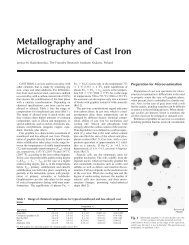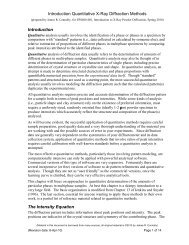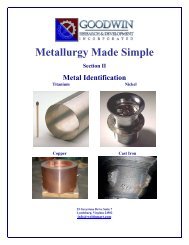ITP Metal Casting: 2002 Metal Casting Industry of the Future ...
ITP Metal Casting: 2002 Metal Casting Industry of the Future ...
ITP Metal Casting: 2002 Metal Casting Industry of the Future ...
You also want an ePaper? Increase the reach of your titles
YUMPU automatically turns print PDFs into web optimized ePapers that Google loves.
North American Die <strong>Casting</strong> Association, General Die Casters, Inc., Peninsula, OH Ryobi Die <strong>Casting</strong> (USA), Inc., Shelbyville, IN<br />
Rosemount, IL General Motors, Detroit, MI Simtec, Inc., Grand Rapids, MI<br />
Albany Chicago Co., Kenosha, WI JL French Corporation, Sheboygan, IN SPX Contech, Portage, MI<br />
Chicago White <strong>Metal</strong>, Basenville, IL Kirby UES , Annapolis, MD<br />
DCD Technologies, Cleveland, OH Lester Precision Die <strong>Casting</strong> Inc.,Solon, OH Walkington Engineering, Inc., Cottage Grove,<br />
Exco Engineering, Ontario, Can Magma Foundry Technologies, Inc., Arlington WI<br />
Flow Science Inc., Los Alamos, NM Hieghts, IL Wright Products Corp., Rice Lake, WI<br />
Prince Machine, Holland, MI<br />
Understanding <strong>the</strong> Relationship Between Pattern Filling and Part Quality in Die <strong>Casting</strong>, Ohio State University - The<br />
objective <strong>of</strong> this project is to understand <strong>the</strong> phenomena involved in <strong>the</strong> filling <strong>of</strong> <strong>the</strong> die cavity and <strong>the</strong> relationships between<br />
fill parameters and part quality. The effects <strong>of</strong> gate geometry at part entry, gate velocity, and slow-to-fast shot acceleration<br />
on filling patterns in die casting, and ultimately part quality, will be explored. The results should produce a better<br />
understanding <strong>of</strong> <strong>the</strong> die filling phenomena under a variety <strong>of</strong> gate entry geometries, selected common cavity geometries, and<br />
gate velocities. The speed <strong>of</strong> fill in <strong>the</strong> die casting process and <strong>the</strong> fact that <strong>the</strong> die cavity is encased in a large envelope <strong>of</strong><br />
steel presents some severe challenges for observing and measuring die fill. The use <strong>of</strong> physical analog (water, ferrometal)<br />
modeling with high-speed video photography will be <strong>the</strong> primary technique used to observe fill patterns. However, <strong>the</strong><br />
technique is limited and must be supplemented with additional measurements and trials. Researchers will attempt to use<br />
real-time x-ray with high-speed video on a limited number <strong>of</strong> trials with zinc and an aluminum die. Additional measurement<br />
trials will be explored. <strong>Casting</strong> trials will follow <strong>the</strong> laboratory and analog studies. The casting trials will allow researchers to<br />
test <strong>the</strong> effects on quality <strong>of</strong> <strong>the</strong> design recommendations resulting from <strong>the</strong> lab studies. Numerical simulations will be<br />
performed for both <strong>the</strong> production and <strong>the</strong> experimental cases. This work will enable improvements in productivity and<br />
quality. Energy and emissions savings arise primarily due to scrap reduction including reductions due to faster startup, less<br />
die tryout, and a better understanding <strong>of</strong> <strong>the</strong> relationship between fill and part quality. An outcome <strong>of</strong> <strong>the</strong> research will be a<br />
computer program that will predict die casting quality level given a set <strong>of</strong> pre-defined gate geometry and processing variables.<br />
This will greatly assist industry to improve productivity and reduce lead-time.<br />
North American Die <strong>Casting</strong> Association, General Die Casters, Peninsula, OH Lester Precision Die <strong>Casting</strong>, Solon, OH<br />
Rosemont, IL GM Bedford, Bedford, IN Walkington Engineering, Cottage Grove, WI<br />
Investment Shell Cracking, Tri-State University- Investment casting is growing in North America and is seen as a means<br />
for steel casting to penetrate high value added markets and high production markets such as automotive. The purpose <strong>of</strong> this<br />
project is to investigate and reduce <strong>the</strong> occurrence <strong>of</strong> investment shell cracking defects in investment casting. Shell cracking<br />
may occur during dewaxing or pouring. The dewaxing problem is one <strong>of</strong> superposition <strong>of</strong> stresses due to constraint <strong>of</strong> free<br />
strain <strong>of</strong> <strong>the</strong> wax by <strong>the</strong> shell. The wax will have a higher <strong>the</strong>rmal expansion coefficient than <strong>the</strong> refractory shell. Robustness<br />
<strong>of</strong> <strong>the</strong> shell in dewaxing and <strong>the</strong>rmal shock resistance during pouring may depend on strength and/or on plane strain critical<br />
stress intensity <strong>of</strong> more exactly critical crack extension force. It is our concept that <strong>the</strong> appropriate bench scale control tests<br />
coupled with manufacturing evaluations will reveal methods to control <strong>the</strong> process for lower scrap rates. The scope <strong>of</strong> work<br />
includes developing bench scale tests for ceramic shells and wax (polymer) pattern materials, designing a standard test casting;<br />
and applying those tests to production materials collected four to six times from participating foundries with concurrent<br />
evaluation <strong>of</strong> defect occurrence from selected worst example case history castings and standardized test casting. The bench<br />
test results will <strong>the</strong>n be correlated with <strong>the</strong> manufacturing results. After that, researchers will examine process parameters,<br />
which can be used to achieve <strong>the</strong> desired trend or range for <strong>the</strong> bench test parameters, and run confirmation tests to determine<br />
that <strong>the</strong> desired results are achieved in manufacturing.<br />
Steel Founders' Society <strong>of</strong> America ABC-NACO, Cicero, IL Wisconsin Invest Cast, Watertown, WI<br />
Barrington, IL Stainless Foundry, Milwaukee, WI PED Manufacturing, Oregon City, OR<br />
Spokane Steel, Spokane, WA Wisconsin Centrifugal, Waukesha, WI Nova Precision, Auburn, PA<br />
B-9€








